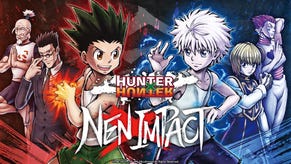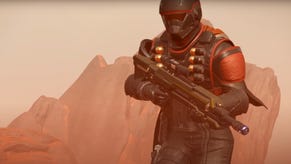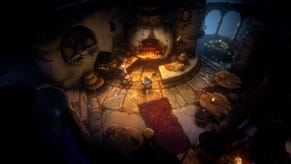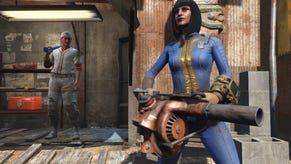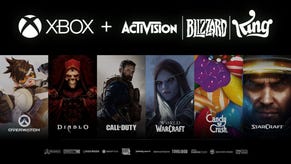The Xbox Story, Part 2: Gunning for Greenlight
In the second part of the story of the original Xbox's launch, Patrick Garratt charts the terrific obstacles facing the console's team as it pushed towards a final greenlight from Microsoft boss Bill Gates.
Hit this for the previous installment, "The Xbox Story, Part 1: The Birth of a Console".
The Xbox project had beaten off a rival console bid from Microsoft’s WebTV group, but the team’s real troubles in getting Xbox to market were only just beginning. It was time for some hard questions.
After the final stand-off with WebTV in front of Gates and Ballmer in June, 1999, there followed a meeting in Ballmer’s "tiny" private conference room with Bachus, Blackley and Bill Veghte, the head of the consumer Windows division.
"He started off by ridiculing us," said Bachus. "He’s a very large personality. Bill sat down and said very quietly, 'Now, Steve, I don’t know how much you know about what the DirectX guys are doing with the Xbox project,' and Steve puts on this screaming voice and goes, 'It’s going to be the biggest thing ever, it’s going to sell billions of units,' basically taunting us about this hype he’s hearing within the company.
"But then he turns. He says, 'Listen. You guys have some serious problems that you have to work out. What’s your cost? What’s your retail mark-up? What’s your reserve for returns?' He’s a salesman. He understands that part of the world really well. He’s a very smart guy."
Ballmer asked them what the retail price was going to be. They told him.
"OK," said the Microsoft head. "Your cost is going to be $200 more than that. I think you guys need to go back and think about this a little more."
"He really shamed us," said Bachus. "There were a lot of uphill battles."
At this point, the struggle to seat the Xbox project within Microsoft was intense. Bachus suffered a constant stream of executives through his office grilling him on the console's USP.
"Microsoft was a spreadsheet company, with blue-screens and crashes and installations. Nintendo hadn’t done much that generation and Saturn had been demolished by PlayStation, so how was anybody able to hold up against Sony?"
Many of them could not grasp its function, and demanded to know if its "silver bullet" was that it ran IE, or did photo editing, or was a consumer Office device.
Bachus had to constantly explain to people that Xbox was a games console: it ran games. It was an unending conversation that ultimately hoisted the the DX team on its own petard.
"When we finally saw what the industrial designers had done with the original Xbox, we weren’t particularly blown away," said Bachus.
"It was disappointing compared to what we had in our heads. But the product was so relatively expensive to build that they economised a bit on the plastic on the outside.
"They were like, 'Well, you told us it was all about the games; it shouldn’t matter what it looks like.'"
Extreme prejudice
It wasn’t just within the company that the team faced serious perception problems. Bachus ran into immediate prejudice to Microsoft entering the console space when he ventured into the outside world with the group’s idea.
"I had to go out and meet with all these developers and publishers and they said we were going to be crushed by Sony," he said.
"Microsoft was a spreadsheet company, with blue-screens and crashes and installations. Nintendo hadn’t done much that generation and Saturn had been demolished by PlayStation, so how was anybody able to hold up against Sony?"
Fries, the man in charge of creating Xbox’s first-party launch line-up, faced the same views over whether or not Microsoft stood any real chance in the console game, but was world weary in that respect.
"Let’s just say I was used to it," he laughed. "Microsoft had been in the games business, really, from the very beginning, putting out versions of Flight Simulator a long time ago, and releasing games like Decathlon. But it had never really been a serious player in games.
"When I took over the games group at the end of ‘95, beginning of ‘96, it was my intention to try to change that, and there were a set of people there who were already in the process of trying to change that.
"I have a shirt in my closet I was laughing about the other day. It was from our first E3, and our marketing guy came up with this self-conscious slogan: 'Microsoft gets games.'
"It sort of showed how much we didn’t get it; we felt we had to say it on our shirts."
At the time Fries first took on Microsoft’s games division, some of the company's first true "gamer" titles were being created, including Ensemble’s original Age of Empires, which released in 1997.
"I think that was our first true hit in the hardcore gaming business on the PC, and it let us establish some credibility and gave us the resources to grow," said Fries.
"We did things like acquiring FASA Interactive and bring in Jordan Weisman, and that added Mech Warrior and Crimson Skies and his other properties, and more people from the hardcore games business into our world.
"By the time Xbox rolled around, I felt that we were reasonably well-established in the PC gaming space. We didn’t have to run around wearing shirts telling people that we 'got games'."
Not far enough
Microsoft first started talking about Xbox with third-party developers at ECTS in 1999. Jez San and other well-trusted figures were briefed on the project.
At the point third-parties became involved the inevitable happened: Xbox sprang a leak.
Said Bachus: "We had this deal with Konami. Konami had the rights to do special PlayStation versions of Microsoft’s PC games, things like Age of Empires. We had the rights to do PC versions of things like Metal Gear Solid.
"Konami went and told Next Gen about the fact we were going to do a games console. That’s how it started leaking out, as we found out several years later.
"But we were mostly able to do it very quietly, much more quietly than I expected us to be able to, and we gathered a huge amount of feedback."
Away from London, Bachus and the team targeted the likes of Tim Sweeney and John Carmack for consultancy. The team started to process the data it had acquired from meetings with various publishers and developers, and the concensus was that Microsoft hadn’t gone far enough: those conversations were instrumental in forcing Xbox away from being simply a rebranded PC.
Bachus and Blackley took their prototype hardware to Vancouver to show it to EA and Microsoft Game Studios and, again, were told that their concept was too great a departure from the current console business. They liked the idea of being able to program games in Windows, but they were sceptical about the machine looking or feeling anything like a PC.
"At one point I remember Bill saying, 'If we don’t have something like Xbox in the marketplace, we don’t have a comprehensive consumer strategy. Either we do Xbox, or we sell the games division to Electronic Arts, we ditch MSN and we just focus on servers and Internet Explorer.'"
While the team spoke to third-parties about software, the hardware side of the project was being pushed towards a self-built box. Dell, specifically, made the decision that it couldn’t make the machine as it didn’t have a slice of the software business involved, meaning hardware price-cutting would never be off-set by an increase in software sales.
Nvidia, too, became a problem. The GPU-builder’s initial estimates for supplying Xbox’s graphics centre became "a lot more expensive," according to Bachus, when Microsoft finally came to placing an order. Nvidia eventually did build the console’s GPU, but it was a custom design created with Microsoft: the two companies ended up in court over their partnership when Microsoft tried to push the chip’s price down in 2002.
"There was a lot of challenge and a lot of struggle with that, and it felt very contentious. Bill, I think, was a huge propellant of what we were trying to do. Steve was a huge opponent. But ultimately, I don’t know, those two guys must have got together in a room: 'Steve, I’ll let you raise the price of Windows in Afghanistan if you let me do Xbox,' or something like that," Bachus joked.
Real progress
The team continued to grow. Bachus and the rest searched Microsoft for staffers who’d already worked in the console world, finding people in the hardware division with first-hand experience of Nintendo and PlayStation. The project was moved onto the consumer side of the company under Robbie Bach, and J Allard took over as project manager.
"He was brought in mostly to be our adult supervision," said Bachus. "The guys running the Microsoft hardware group felt they needed more Microsoft veterans on the project, so that J could go into Ballmer and say, 'Remember how I told you the internet was going to be a big deal and it was? Well, now I’m telling you that Xbox applications need to run in kernel mode.'"
As the obstacles to launch began to fall, Bachus and the rest of the team were given permission to quit their DirectX day-jobs and move onto Xbox as a full-time project. As insane as it seems now, everything accomplished up to this point had been a sideline. This was in September, 1999, six months after the project was initially born.
At this point, the original DirectX group split. Otto Berkes and Ted Hase decided to stay within their original roles: they were long-time Microsoft staff, and had strong ties to their divisions. Bachus, however, had only been at the company for two years, and Blackley had been there for an even shorter time. They both moved onto the Xbox project as a priority.
"We were very passionate about Xbox, and when we had the opportunity to follow it we did," said Bachus.
Even now, there was no final greenlight on Xbox. It could easily have been cancelled.
"Our task was really to try to prove out every outrageous assertion that we'd made: that we could get publishers on board, that we could build this thing, that it could be done, that it could be successful. There was definitely risk there."
Bachus and Blackley started serious talks with hardware manufacturers, including a trip up to Canada to see ATI in a rented Bug.
"We were quite the couple in our bright yellow VW Beetle," Bachus recalled.
This period lasted for around six months. Publishers and developers were rounded on again, and decisions were made on ATI versus AMD, 3dfx versus Nvidia, and so on. Bachus's role shifted, with him moving from finance to hardware planning, making decisions on how many connectors the final box would have and which cables would be included in the pack.
When full-time engineers joined the team, it changed again, and he was given the responsibility of looking after third-party software relations while Fries readied the first-party line-up.
Blackley eventually moved onto developer support, but Bachus and Blackley both found this period of escalation difficult.
"We struggled to find our identity," said Bachus. "When J was brought on board it was like, 'You have to look after Kevin and Seamus,' but he wanted to bring in his own people. We were trying to sort out the organisational structure as well as talking to all these people outside of the company, trying to figure out how to do it and be clever about it."
Ultimately, though, the team coped with its growing pains and succeeded in creating a solid plan. Six months after moving onto the project full-time, the Xbox unit sought final approval to release Microsoft’s first videogames console.
The key meeting with Ballmer and Gates took place on February 14, 2000, just before the first, legendary Xbox tech demos were shown at GDC in San Jose, California. This was a tough call: Fries calls it the "Valentine's Day Massacre," and it decided not only the shape of Xbox’s future, but that of the overall direction of Microsoft, the world’s largest company.
My Bloody Valentine
A positive outcome for this meeting meant Xbox would exist. A thumbs down would send the console team back to developing Windows.
As Rick Thompson told Dean Takahashi in an interview for Opening the Xbox: "We looked around at each other around the table and asked if we really wanted to lose billions of dollars over eight years."
Bachus told VG247: "We got together on February 14. This is Valentine's Day, right? Everyone’s supposed to go home and be with their wives; this thing drags on for hours.
"It was very contentious. At one point I remember Bill saying, 'If we don’t have something like Xbox in the marketplace, we don’t have a comprehensive consumer strategy. If we’re not going to do Xbox, I see that the decision is that we’re either an enterprise software company like Oracle, or we are a more comprehensive software company that encompasses consumer issues as well. So, either we do Xbox, or we sell the games division to Electronic Arts, we ditch MSN, we get out of all this other stuff, and we just focus on servers, Internet Explorer, and so on.'
"And no one really wanted to do that. I think that was what ultimately broke the loggerheads. Up to that point, and I’m sure beyond that, but certainly up to that point, there were a lot of things that could have caused the project to be terminated.
"We really didn’t make it easy for ourselves in that things changed from the original concept. Now we wanted Microsoft to build the hardware, and the components were more expensive than we thought. We didn’t want it to run Windows software, but instead something that was API-similar, in the same way that iPhone apps are similar to MacOS apps.
"You can’t run a Mac app on an iPhone, and you can’t run a PC game on an Xbox. That’s why the homebrew scene was so active on Xbox when it first came out: it’s similar to Windows, but it’s not running Windows.
"There was a lot of brain damage with that. But we were still able to go through with it."
Said Fries: "It started at four o’clock. Bill and Balmer yelled at us for hours and hours, until seven or eight at night. In the last five minutes of the meeting they changed their minds. They decided to approve the project.
"A big part of why they were mad was because we were telling them that we were dropping Windows, and that we were doing this custom OS for it."
The team had been told time and again that Xbox needed to be a "true console," as Fries described it.
"It started at four o’clock. Bill and Balmer yelled at us for hours and hours, until seven or eight at night. In the last five minutes of the meeting they changed their minds. They decided to approve the project."
"It needed to have a very thin, light operating system that we had a ton of control over, and that meant dropping Windows," he said.
"And that was a very difficult discussion when we brought it up with Bill Gates."
Changing the Xbox OS was a huge deal for Gates, although it’s not easy to see why looking back from so far away.
"You have to put yourself in their shoes," said Fries. "They run this big company, and they’re trying to coordinate the actions of lots and lots of different groups, and every group wants to go off in its own direction. They all have their own reasons for why they should reinvent everything - developers love to do that - and why they shouldn't share, or work together, or coordinate, because they don't trust the other groups to get everything done on time. It’s always easier to go out on your own than to work together.
"They’re trying to wrangle all these groups to do what, in their view is the right thing: working on big, strategic initiatives for the company that are bigger than any one team, and in general that’s the right thing for them to do.
"But in the case of Xbox, what was really the right thing to do, and what they ultimately approved, was to separate us, to really say, 'What you’re doing is completely different. Go off on your own and make it work.'"
They’d won. Microsoft would launch Xbox. The Valentine's meeting was held just before GDC that year, and Gates himself was booked to speak, which was, in itself, previously unthinkable. There was great excitement in the western games world. The week before the GDC keynote on March 10, 2000, Bachus went to Gates' office, showed him the Xbox tech demos and "got him ready". They connected up one of the prototype machines to a monitor and showed him the presentation software.
This was the start of Xbox’s public push. We were about to see Bill Gates in a leather jacket.
Part 3 - GDC, CES and the rush to launch.









